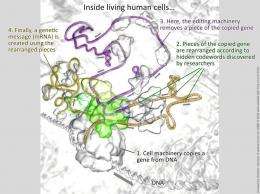Researchers crack 'splicing code,' solve a mystery underlying biological complexity

Researchers at the University of Toronto have discovered a fundamentally new view of how living cells use a limited number of genes to generate enormously complex organs such as the brain.
In a paper published on May 6 in the journal Nature entitled "Deciphering the Splicing Code," a research team led by Professors Brendan Frey and Benjamin Blencowe of the University of Toronto describes how a hidden code within DNA explains one of the central mysteries of genetic research - namely how a limited number of human genes can produce a vastly greater number of genetic messages. The discovery bridges a decade-old gap between our understanding of the genome and the activity of complex processes within cells, and could one day help predict or prevent diseases such as cancers and neurodegenerative disorders.
When the human genome was fully sequenced in 2004, approximately 20,000 genes were found. However, it was discovered that living cells use those genes to generate a much richer and more dynamic source of instructions, consisting of hundreds of thousands of genetic messages that direct most cellular activities. Frey, who has appointments in Engineering and Medicine, likens this discovery to "hearing a full orchestra playing behind a locked door, and then when you pry the door open, you discover only three or four musicians generating all that music."
To figure out how living cells generate vast diversity in their genetic information, Frey and postdoctoral fellow Yoseph Barash developed a new computer-assisted biological analysis method that finds 'codewords' hidden within the genome that constitute what is referred to as a 'splicing code'. This code contains the biological rules that are used to govern how separate parts of a genetic message copied from a gene can be spliced together in different ways to produce different genetic messages (messenger RNAs). "For example, three neurexin genes can generate over 3,000 genetic messages that help control the wiring of the brain," says Frey.
"Previously, researchers couldn't predict how the genetic messages would be rearranged, or spliced, within a living cell," Frey said. "The splicing code that we discovered has been successfully used to predict how thousands of genetic messages are rearranged differently in many different tissues." Blencowe's group, including graduate student John Calarco, generated experimental data used to derive and test predictions from the code. "That the splicing code can make accurate predictions on such a large scale is a major step forward for the field," says Blencowe.
Frey and Blencowe attribute the success of their project to the close collaboration between their team of talented computational and experimental biologists. "Understanding a complex biological system is like understanding a complex electronic circuit. Our team 'reverse-engineered' the splicing code using large-scale experimental data generated by the group," Frey said.












